Baoshan Iron & Steel Bundle
Can Baoshan Iron & Steel Company Maintain Its Steel Dominance?
Baoshan Iron & Steel Co., Ltd. (Baosteel), a global titan in the steel industry, is a cornerstone of China's industrial might. From its humble beginnings in 1978, Baosteel has risen to become a leader in carbon steel, stainless steel, and special steel production, serving critical sectors like automotive and construction. This deep dive explores Baosteel's ambitious Baoshan Iron & Steel SWOT Analysis, growth strategy, and future prospects in a rapidly evolving global market.
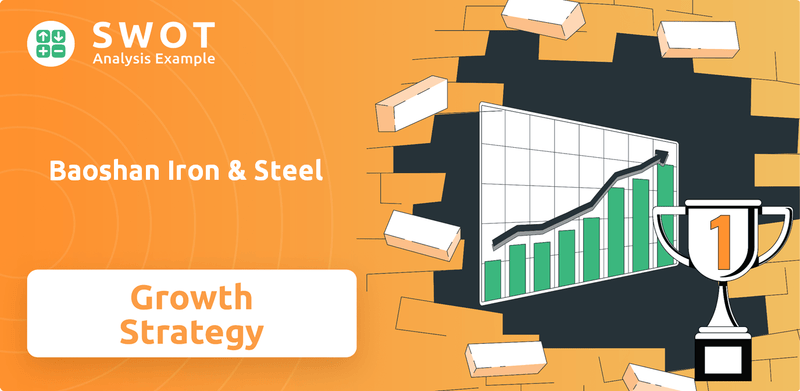
Baosteel's strategic focus on technological innovation and sustainable development, alongside its impressive production capacity, positions it at the forefront of the Chinese steel market. Understanding Baosteel's expansion plans and its ability to navigate the competitive landscape is crucial for anyone seeking to understand the dynamics of the steel industry. This analysis will delve into Baosteel's financial performance, strategic partnerships, and digital transformation strategy, offering insights into Baosteel's long-term goals and its impact on the global steel market.
How Is Baoshan Iron & Steel Expanding Its Reach?
Baoshan Iron & Steel Company, or Baosteel, is actively pursuing several expansion initiatives to strengthen its market position and diversify its revenue streams. These initiatives are crucial for the company's Baosteel growth strategy and future prospects. The company aims to capitalize on its strengths and adapt to the evolving dynamics of the Steel industry and the Chinese steel market.
A primary focus of Baosteel's expansion involves increasing high-margin exports. The company has set a target to boost steel exports to 10 million tons annually by 2028. This strategy leverages Baosteel's extensive product range and well-established international marketing network. In 2024, Baosteel achieved a record high of 6.07 million tons of steel product exports, marking a 3.9% year-on-year increase. This growth demonstrates the company's commitment to expanding its global footprint.
Despite anticipated declines in direct steel exports from China, Baosteel is strategically expanding its presence through new product categories and joint ventures. The company is also focusing on local and regional collaborations to drive growth and stay ahead of evolving industry demands. These efforts are designed to access new customer segments and diversify revenue streams, ensuring Baosteel's continued success in a competitive landscape.
Baosteel is targeting to increase high-margin exports to 10 million tons annually by 2028. This strategy leverages the company's broad product range and established international marketing network. The company shipped a record 6.07 million tons of steel products in 2024, a 3.9% year-on-year increase.
Baosteel is expanding its presence in new product categories and through joint ventures. In February 2025, Baosteel, Baowu Aluminum Technology Co., Ltd., and Kobe Steel, Ltd. launched a joint venture. This move into advanced materials for the automotive sector is a key part of Baosteel's corporate strategy.
Baosteel's LNG marine invar steel has broken technological monopolies, marking a significant step towards high-end ship applications. This innovation highlights Baosteel's commitment to technological advancements. These advancements are crucial for Baosteel's long-term goals.
Baoshan District, where Baosteel is located, is emphasizing future health, future materials, and future intelligence. This includes advancing key industries like synthetic biology. This approach aligns with Shanghai's identified future industries, fostering regional growth.
Baosteel is actively pursuing several expansion initiatives to solidify its market position and diversify its revenue streams. These initiatives are designed to access new customer segments and diversify revenue streams away from traditional markets.
- Increase high-margin exports, targeting 10 million tons annually by 2028.
- Expand into new product categories and through joint ventures, such as the automotive sector.
- Focus on local and regional collaborations to drive growth and stay ahead of evolving industry demands.
- Leverage technological advancements, such as LNG marine invar steel, to enter high-end markets.
Baoshan Iron & Steel SWOT Analysis
- Complete SWOT Breakdown
- Fully Customizable
- Editable in Excel & Word
- Professional Formatting
- Investor-Ready Format
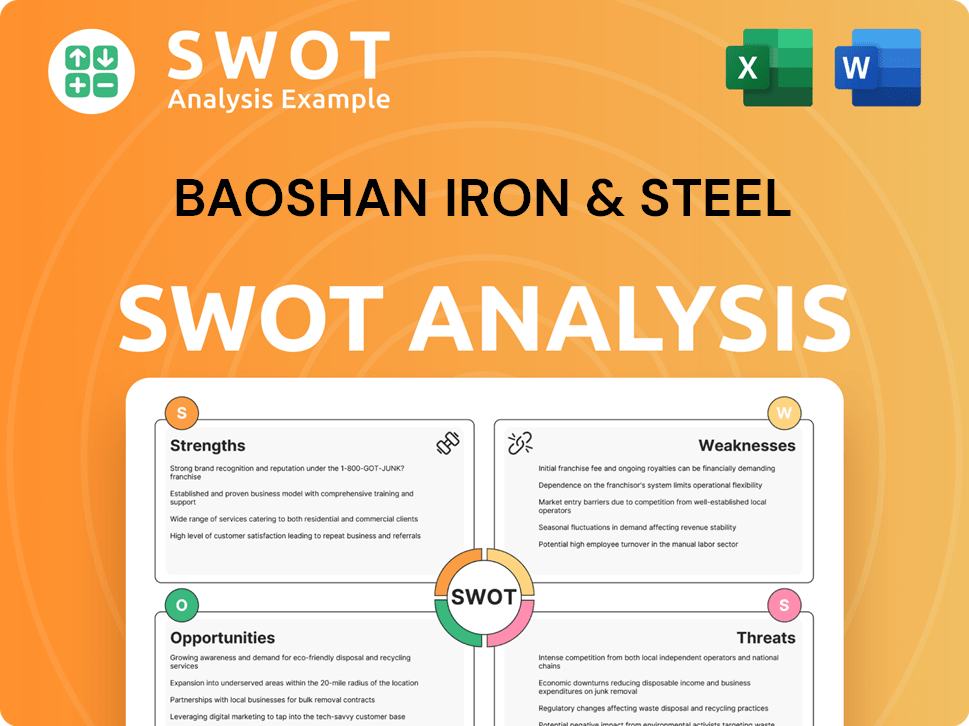
How Does Baoshan Iron & Steel Invest in Innovation?
Baoshan Iron & Steel Company (Baosteel) is deeply committed to innovation and technology as key drivers of its growth strategy. This focus is evident in its significant investments in research and development, digital transformation, and sustainable practices. Baosteel's commitment to these areas positions it well within the dynamic steel industry and contributes to its future prospects.
The company's strategic approach involves a multi-faceted strategy that integrates technological advancements with environmental sustainability. This integrated approach aims to improve operational efficiency, reduce costs, enhance product quality, and minimize its environmental footprint. Baosteel's proactive stance reflects its commitment to adapting to the evolving demands of the Chinese steel market and the global steel industry.
Baosteel's dedication to innovation is evident in its collaborative research efforts and technological implementations, which are critical for maintaining its competitive edge and achieving its long-term goals. For a deeper understanding of how Baosteel approaches its market, consider exploring the Marketing Strategy of Baoshan Iron & Steel.
Baosteel actively invests in research and development to drive innovation. The Baosteel Australia Joint Research and Development Centre (BAJC) is a key initiative.
BAJC provides up to $2,000,000 in funding for research projects. Approved projects are scheduled to commence on January 1, 2025.
Research initiatives prioritize advanced steel materials and processes. The goals are to reduce costs, improve product quality, and enhance energy efficiency.
Baosteel embraces digital transformation, particularly through the implementation of 5G technology for smart steel production. The Baoshan Base is a key site for this.
The Baoshan Base has built 43 5G communication base stations. There are plans to add 20 more in 2024 to eliminate signal blind spots.
5G technology supports remote control of cranes, slag adding robots, automatic driving of AGVs, and AI for scrap steel grading and steel surface inspection.
These 5G applications have led to significant improvements in operational efficiency and environmental impact. The company has demonstrated its commitment to Baosteel sustainable development initiatives.
- Recycling of 250,000 tons of scrap steel.
- Reduction of 1.732 million tons in carbon dioxide emissions in 2022.
- Annual labor cost reduction of 54 million yuan.
Baosteel is at the forefront of sustainability within the steel industry. Their efforts are a key part of their Baosteel future prospects.
- Achieved a 30% carbon reduction in the production of low-carbon oriented and non-oriented silicon steel in 2024.
- Dongshan and Baoshan bases received the Performance A-level enterprise award for 2022 for ultralow emission transformation.
- Developed the industry's first carbon management information system.
- Announced the use of nearly 100% low carbon emissions steel for a commercial real estate project in Shanghai in November 2024, resulting in a 35% reduction in embodied carbon emissions.
- Constructing a zero-carbon plant in Zhanjiang, Guangdong, powered by green hydrogen and green electrical energy, with completion expected in 2025.
- The Zhanjiang project includes a million-ton hydrogen-based shaft furnace project expected to be completed in 2025, aiming to reduce carbon dioxide emissions and disrupt traditional steelmaking processes.
Baoshan Iron & Steel PESTLE Analysis
- Covers All 6 PESTLE Categories
- No Research Needed – Save Hours of Work
- Built by Experts, Trusted by Consultants
- Instant Download, Ready to Use
- 100% Editable, Fully Customizable
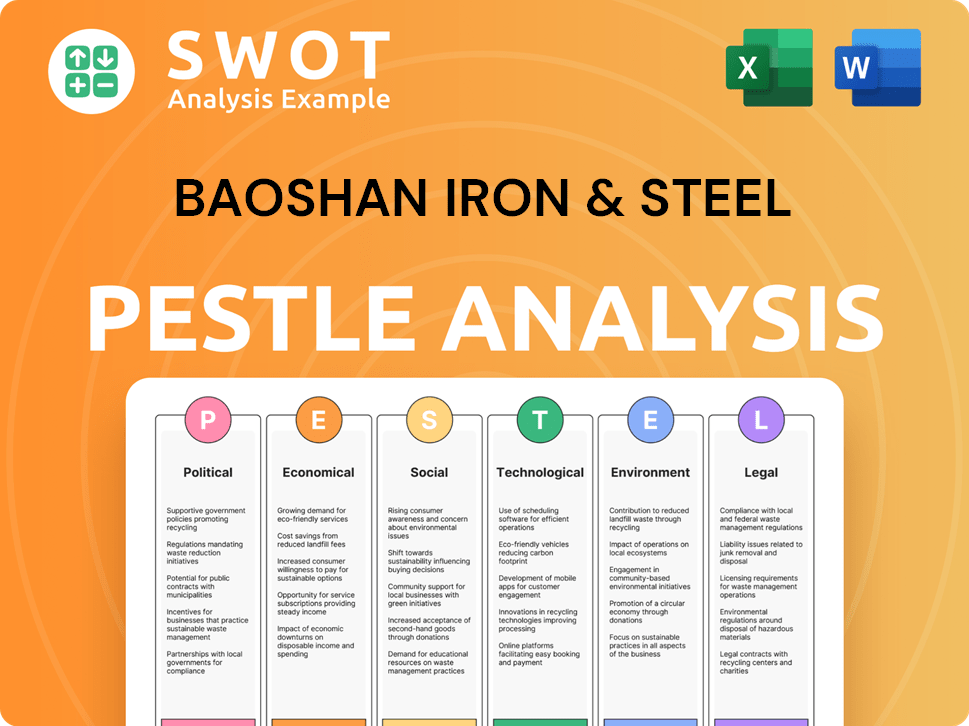
What Is Baoshan Iron & Steel’s Growth Forecast?
The financial outlook for Baoshan Iron & Steel Company (Baosteel) in early 2025 presents a mixed picture. Baosteel's financial performance in the first quarter of 2025 showed a significant increase in net profit, but the company faces challenges due to falling steel prices and weak demand in the steel industry. The company's strategy focuses on high-end products and exports to navigate the complex market conditions.
In Q1 2025, Baosteel reported a 26.4% year-on-year increase in net profit, reaching approximately 2.43 billion yuan ($333.43 million). This positive trend was driven by lower costs, particularly a decrease in coking coal prices. However, the company's operating income declined due to falling steel prices and ongoing market challenges. The company's strategic focus is on enhancing high-margin exports and meeting the rising demand from sectors like electric vehicle manufacturing.
Despite the Q1 profit increase, the full-year 2024 net profit saw a 38.4% drop to 7.36 billion yuan, reflecting the broader industry struggles. Baosteel's ability to adapt to these conditions, including managing costs and strategically targeting exports, will be crucial for its financial health in 2025 and beyond. The company’s strategic initiatives are designed to improve its competitive position within the Chinese steel market.
Baosteel's net profit increased by 26.4% year-on-year in Q1 2025, reaching approximately 2.43 billion yuan ($333.43 million). This increase was mainly due to reduced costs, especially in coking coal. This financial performance indicates a strong start to the year, despite broader market challenges.
In 2024, Baosteel's net profit decreased by 38.4% to 7.36 billion yuan. This decline reflects the challenging market conditions and falling steel prices. The 2024 results highlight the impact of industry-wide issues on Baosteel's profitability.
Baosteel plans to produce 52.61 million tons of steel and 48.79 million tons of pig iron in 2025. The company is adjusting its production strategy in response to the projected decrease in domestic steel consumption. These production targets are crucial for meeting demand while managing overcapacity issues.
Baosteel aims to increase its high-margin exports to 10 million tons annually by 2028. This strategic focus on exports is designed to offset the anticipated decline in domestic demand and global trade frictions. This expansion is a key component of Baosteel's growth strategy.
Analysts forecast Baoshan Iron & Steel's revenue for Q2 2025 to be 71.262 billion CNY and EPS for Q2 2025 to be 0.088. The company's leadership remains optimistic about its financial performance in 2025, emphasizing a 'high-end, smart, and green' strategy to meet rising demand. For more insights, consider exploring the Competitors Landscape of Baoshan Iron & Steel.
Baosteel faces challenges from falling steel prices, weak demand, and trade tensions. These factors have impacted the company's operating income and overall profitability. The company must navigate these challenges to maintain its financial performance.
Baosteel's strategic focus includes increasing high-margin exports and targeting the electric vehicle sector. These initiatives are designed to boost profitability and capitalize on growing market demands. The company is adapting its strategy to align with evolving market needs.
The steel industry is experiencing a nationwide reduction in output due to overcapacity and trade frictions. Domestic consumption is projected to decline by 2%. Baosteel's strategic adjustments are critical for navigating this challenging market environment.
Baosteel is investing in technological advancements to enhance its production efficiency and product quality. These innovations support the company's goal of producing high-end products. These advancements are key to maintaining a competitive edge.
Baosteel is committed to sustainable development initiatives to reduce its environmental impact. This includes implementing green technologies and practices. These efforts align with global trends toward sustainability.
Baosteel's long-term goals include expanding its market share and enhancing its global competitiveness. The company aims to achieve these goals through strategic investments and innovative approaches. These long-term goals are crucial for Baosteel's sustained success.
Baoshan Iron & Steel Business Model Canvas
- Complete 9-Block Business Model Canvas
- Effortlessly Communicate Your Business Strategy
- Investor-Ready BMC Format
- 100% Editable and Customizable
- Clear and Structured Layout
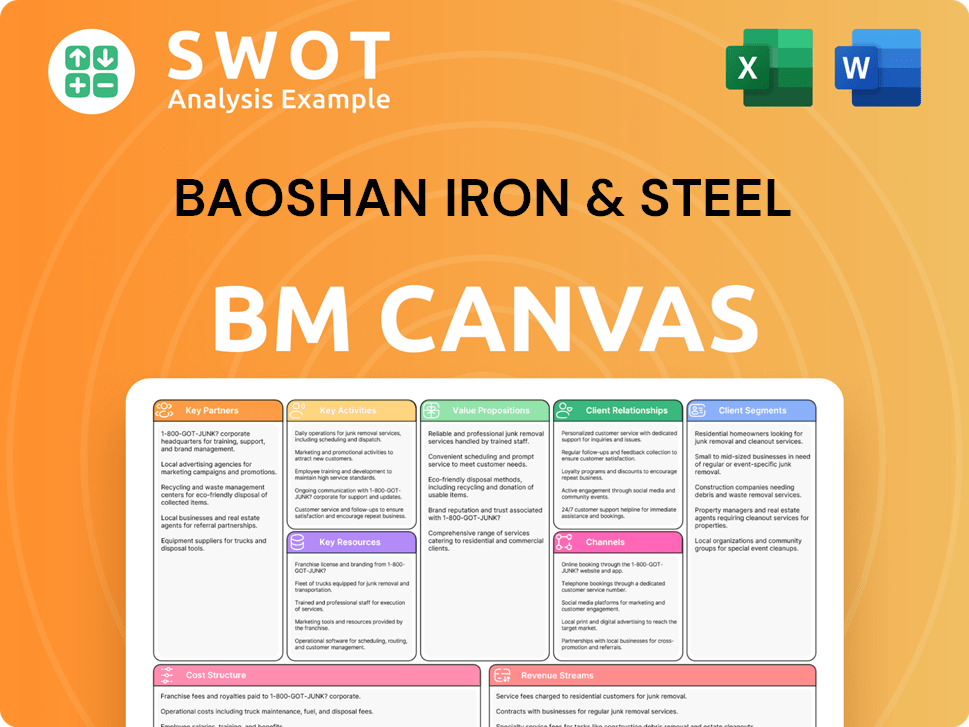
What Risks Could Slow Baoshan Iron & Steel’s Growth?
Baoshan Iron & Steel Company (Baosteel) faces significant challenges that could affect its Baosteel growth strategy and Baosteel future prospects. These risks stem from market dynamics, regulatory changes, and the broader economic climate. Understanding these obstacles is crucial for assessing the company's long-term viability and investment potential.
The Chinese steel market, a key area for Baosteel, is grappling with overcapacity and fluctuating demand, particularly from the real estate sector. Global trade tensions and rising protectionism also pose considerable threats, potentially impacting Baosteel's export capabilities and profitability. Furthermore, stringent environmental policies add to the operational complexities, potentially increasing costs and requiring significant strategic adjustments.
To navigate these challenges, Baosteel is focusing on cost efficiencies and strategic diversification. The company is also actively engaging with authorities to advocate for policies that consider market realities. This proactive approach is vital for mitigating risks and ensuring sustained growth in a volatile environment. For more information, check out this article about Revenue Streams & Business Model of Baoshan Iron & Steel.
Persistent overcapacity within the Steel industry in China, coupled with weakened domestic demand, is a major challenge. The real estate sector's slowdown significantly impacts Baosteel's expansion plans. This oversupply environment puts downward pressure on prices and profit margins, affecting Baosteel financial performance.
Rising protectionism and trade disputes pose a significant risk to Baosteel. Direct and indirect steel exports from China are projected to decrease, impacting revenue streams. These trade barriers could limit Baosteel's market share analysis and hinder its ability to compete in international markets.
Stringent environmental policies and the push for reduced carbon emissions add to Baosteel's operational costs. Compliance with these regulations, including potential carbon emission quota purchases, could impact Baosteel's challenges and opportunities. Investment in Baosteel sustainable development initiatives is crucial.
A general economic slowdown in China and globally could decrease demand for steel. This decrease would directly affect Baosteel's sales volume and profitability. The company's ability to adapt to changing economic conditions is critical for its survival and growth.
Fluctuations in the prices of raw materials, such as iron ore and coal, can significantly impact Baosteel's cost structure. Unpredictable raw material costs can squeeze profit margins and make financial planning difficult. Effective supply chain management is essential.
Rapid Baosteel technological advancements in the steel industry could render existing technologies obsolete. The company must invest in research and development to stay competitive. Embracing digital transformation is essential to streamline operations.
Baosteel is focusing on cost efficiencies, which contributed to its Q1 2025 profit surge, to combat rising costs and maintain profitability. The company is also appealing to authorities for differentiated policies. Management is emphasizing a shift towards high-margin exports and advanced steel products to diversify revenue streams and reduce reliance on traditional markets.
A nationwide reduction in steel output is anticipated in 2025, with a potential 50 million metric ton cut in China's crude steel output. Domestic steel consumption is projected to decline by 2% in 2025. Direct steel exports from China are expected to drop by 15 million tons in 2025.
Baoshan Iron & Steel Porter's Five Forces Analysis
- Covers All 5 Competitive Forces in Detail
- Structured for Consultants, Students, and Founders
- 100% Editable in Microsoft Word & Excel
- Instant Digital Download – Use Immediately
- Compatible with Mac & PC – Fully Unlocked
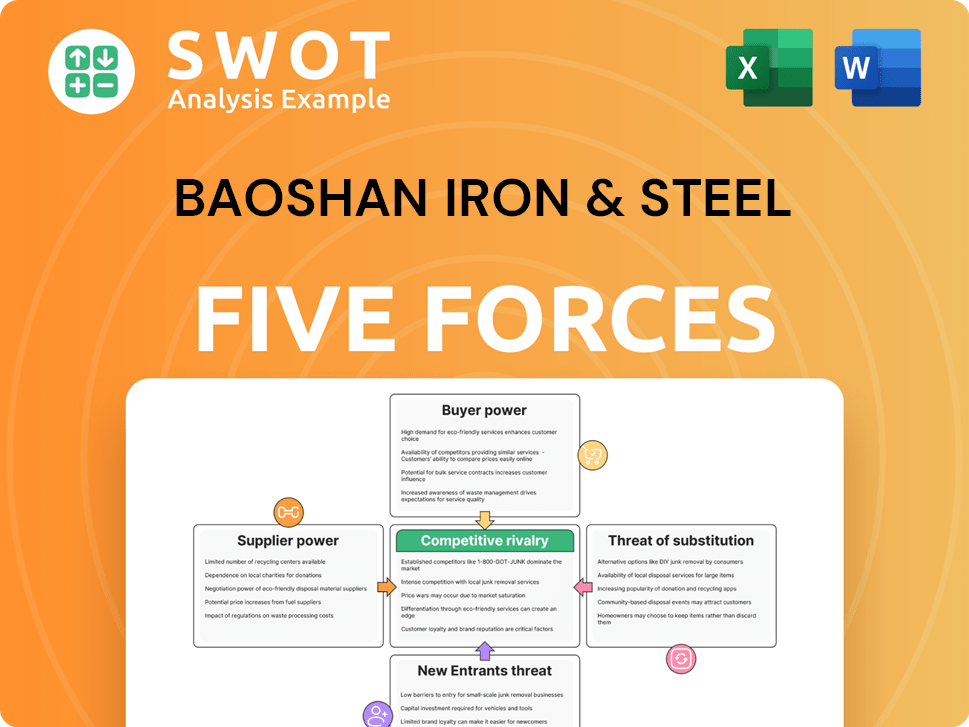
Related Blogs
- What are Mission Vision & Core Values of Baoshan Iron & Steel Company?
- What is Competitive Landscape of Baoshan Iron & Steel Company?
- How Does Baoshan Iron & Steel Company Work?
- What is Sales and Marketing Strategy of Baoshan Iron & Steel Company?
- What is Brief History of Baoshan Iron & Steel Company?
- Who Owns Baoshan Iron & Steel Company?
- What is Customer Demographics and Target Market of Baoshan Iron & Steel Company?
Disclaimer
All information, articles, and product details provided on this website are for general informational and educational purposes only. We do not claim any ownership over, nor do we intend to infringe upon, any trademarks, copyrights, logos, brand names, or other intellectual property mentioned or depicted on this site. Such intellectual property remains the property of its respective owners, and any references here are made solely for identification or informational purposes, without implying any affiliation, endorsement, or partnership.
We make no representations or warranties, express or implied, regarding the accuracy, completeness, or suitability of any content or products presented. Nothing on this website should be construed as legal, tax, investment, financial, medical, or other professional advice. In addition, no part of this site—including articles or product references—constitutes a solicitation, recommendation, endorsement, advertisement, or offer to buy or sell any securities, franchises, or other financial instruments, particularly in jurisdictions where such activity would be unlawful.
All content is of a general nature and may not address the specific circumstances of any individual or entity. It is not a substitute for professional advice or services. Any actions you take based on the information provided here are strictly at your own risk. You accept full responsibility for any decisions or outcomes arising from your use of this website and agree to release us from any liability in connection with your use of, or reliance upon, the content or products found herein.